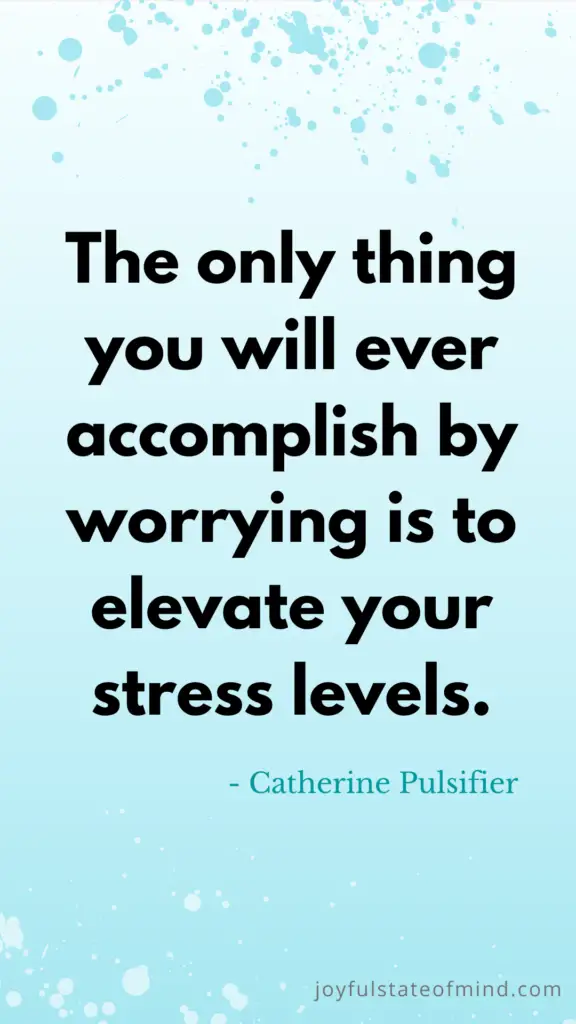How To Stop Worrying and Be Happy Now: 11 Simple Secrets

We might not be able to eliminate worries, but we can learn to manage worry better so it doesn’t have control over us. Here are 11 simple yet powerful and proven ways to stop worrying and be happy right now.
This post contains affiliate links, which means I may earn a small commission if you make a purchase, at no cost to you. See my disclaimer for more info.
Worry Takes Away Your Happiness
It was a beautiful summer vacation day (and my birthday), and we headed to one of our favourite places.
The sun was shining, the flowers were in full bloom, and there was no cloud in the sky. I was wearing my cute new dress, and my girls were beaming with joy as they played. So we laid out comfy blankets for a family picnic.
A recipe for a super-fun summer day, right?
Well, not so much for me.
Despite it being a perfect day, my mind had other plans: to be consumed by worry and negative thoughts.
And the worst part is I knew I was going down this spiral and couldn’t seem to stop it.
It started with disappointment that morning, which triggered memories that made me go over past hurts. So naturally, I started worrying about the future and uncertainties I had no control over. Yikes! 🤷♀️
This story has a happy ending, though, I promise; it just took a bit of work to get there. Stay tuned to find out how it ends in my conclusion below.
First, let’s cover a few areas because knowledge is power, so grab a cup of tea and let’s dive a little deeper.
Disclaimer: This post is not medical advice. Connect with a doctor or therapist if you are struggling with any mental health concerns. Any resources shared in this post are for informational purposes and do not replace professional treatment. See disclaimer for more details.
A Woman’s Worry Is Never Done, Or Is It?

I’ve been a worrier for as long as I can remember. When I became a mom, my worry only increased as now I had two little people to worry about.
I was emotionally exhausted and frustrated by being in a constant state of worry.
Like most of us, instead of showing myself grace, I blamed myself for being too “high-strung” and “nervous.”
But the truth was I was a master at worrying. And believe me, when I say I was a master, I worried about worrying, then worried some more. 🤦🏻♀️
There’s no shortage of things to worry about with careers, school, children, partners, financial struggles, and other responsibilities.
That old saying, “A woman’s work is never done,” could easily be changed to “A woman’s worry is never done.”
To an extent, this is true, but we can learn to better manage and control our worries so we have more balance in life and can enjoy our everyday journey instead of always being in a state of worry.
Awareness Is Essential
The most important step is being aware of a problem and admitting you need help.
You’re here. You’re reading this. That’s awesome.
Everything else is one step after the other, and before you know it, things are manageable, and you’re in a better place to deal with challenges.
Life is full of problems; we can be weighed down by them and stay stuck in unhealthy patterns, or we can see them as obstacles to overcome, learn from, and grow.
Life isn’t perfect, and like everyone, I still have worries, but the difference is anxious thoughts don’t control me as they once did.
Believe it or not, being diagnosed with Generalized Anxiety Disorder (GAD) years ago was a relief because now I knew where my struggles were coming from and could take steps to start healing.
If you’re wondering, the main symptom of GAD is excessive and chronic worrying. (1)
Related article: 30-Day Mental Health Challenge + Free Printables
The Slippery Slope of Worry
Worry is when we feel uneasy and or concerned about a problem or circumstance.
It’s part of our body’s reaction to stress. Excessive worry can affect your daily life, mental and physical health, and relationships. (2)
A Psychology Tools article clearly explains what worry is:
When you worry, you think about problems that might happen in a way that leaves you feeling anxious or nervous. Worry is a chain of thoughts and images that can progress in ever more catastrophic and unlikely directions. It often feels hard to control and seems to take on a life of its own. (3)
Think of worrying as a slippery slope that becomes a habit and is part of negative patterns of thinking called “cognitive distortions.”
Worrying and Cognitive Distortions
If you’re a chronic worrier, it’s essential to understand negative thinking patterns because you may not be aware that you do them.
When I first learned about cognitive distortions, it was so eye-opening.
It made me realize how cognitive distortions seriously impacted my thoughts and how much I was worrying.
Now, when my mind is on that slippery slope, I easily identify how I’m thinking and then challenge and change those thoughts. Yay to that! 🎉
These are some common cognitive distortions (4):
- Catastrophizing: Assuming the worst-case scenario will happen about a situation or event, no matter what, even if you have no evidence to support that.
- Personalization: You take everything too personally, thinking everything others do or say is somehow a direct reaction to yourself. For example, if someone doesn’t smile, they are mad at you.
- Overgeneralization: Assuming things will always be a certain way or coming to conclusions based on a single incident.
- Disqualifying the positive: Not acknowledging success or good things; instead, you always notice the negative about a person, situation, or yourself.
- Polarized (black-and-white) thinking: It’s all or nothing. You don’t see the middle ground or lesson. You’re a winner or a total failure.
- Jumping to conclusions: This has two forms. One is ‘mind-reading,’ so you think you know what people are thinking. The second is ‘fortune-telling,’ where you predict that the worst will happen without considering the odds of that outcome actually happening.
- Emotional Reasoning: Whatever you feel during your thoughts or worries must be accurate. You assume that the negative feeling you’re having is the only truth.
Don’t Worry, Be Happy
In every life, we have some trouble
But when you worry, you make it double
Don’t worry, be happy
–Bobby McFerrin
It may not be as easy as the song suggests, but problems are inevitable, and worrying only magnifies them.
You’ll begin to see progress when you’re actively taking steps to stop worrying and be happier.
Worry makes problems seem worse than they may be, and it’s often the worrying that causes more suffering.
So you may be wondering…
Why Is It So Dang Hard To Stop Worrying, Anyways?
This is the million-dollar question that everyone with anxiety has tried to figure out by worrying about why we can’t stop worrying. Am I right? 🤦🏻♀️
Once you start to worry, it’s easy to fall into a cycle of anxious thoughts.
We know it’s not helping, so it feels like a frustrating pattern, but that’s the problem: we worry out of habit.
And it’s an ingrained habit that’s difficult to get out of without the right tools or strategies.
Some reasons psychologists believe it’s hard to stop worrying: (5)
- You have a high intolerance for uncertainty.
- You have positive beliefs about worry (i.e. I worry because I’m a caring person).
- You approach problems with a negative mindset.
- You engage in cognitive avoidance (i.e. suppressing your thoughts, trying to avoid or escape your thoughts).
From personal and professional experience, I can tell you that although there’s no simple answer to this question, it’s possible to stop worrying so much.
Why Worrying Is A Waste of Time
Worry is our internal talk and how our brain processes challenges and fear.
Sometimes, worry can be a good thing as it motivates us to prepare and find solutions to real problems.
But we tend to worry about things that happened in the past or uncertainties about the future.
These worries are a complete waste of time because our minds quickly jump to worst-case scenarios, which is emotionally draining.
Worry only takes away from you, experiencing more joy in the present moment and self-sabotaging moments, such as I did on that vacation day.
Want To Stop Worrying & Be Happy: Be Kind To Yourself

If any of this resonates with you, please don’t be hard on yourself; this isn’t about blame or your inability to stop the worry.
If you’re a worrier by nature, your mind is programmed to start worrying; think of it as your mind’s default setting.
It’s a defence mechanism to protect you from those dangerous or worst-case scenarios, and that’s not something you can quickly stop without practice.
If you struggle with being a people-pleaser, this can also add to your worry. So take time to learn how to stop being a people pleaser but still be kind.
The great news is that there are many strategies you can use to stop worrying and be happy.
None are complicated, but they take an open mind and consistent effort.
Stop Worrying & Be Happy Because It Affects Your Body
Everyone worries, but excessive worry makes it difficult to be happy, which has detrimental impacts on your mental and physical health.
From developing mental health disorders, anxiety is the obvious one, but chronic worry also lowers your mood and can lead to depression.
There are many ways worry can impact our physical health and cause a variety of symptoms, which include but aren’t limited to (6 & 7):
- Racing heartbeat
- Headaches
- Clearing your throat
- Fatigue
- Stomach aches and many gastrointestinal issues
- Back pain
- Irritability
- Shortness of breath
- Chest pain
- Short-term memory loss
- Excessive sweating
- Muscle tension
- Shaking or trembling
- Loss of energy or having nervous energy
- Feeling nauseous
A Solid Foundation

When it comes to how our minds function throughout the day, we must ensure we’re taking care of our basic needs to have a solid foundation. This is essential to stopping worrying and being happy.
Just like we can’t drive cars without gas, our bodies and minds will break down if we don’t care for them and fuel them with healthy things.
- Get your body moving. Regular exercise is the best way to lower stress. If you don’t like the gym, try walks or dance parties at home, or invest in a stationary bike. There are also tons of free workout videos on YouTube. Here are a few good ones: The Body Coach TV, Heather Robertson, and Fitness Blender.
- Get good sleep. It is crucial to get quality sleep and have a regular sleep schedule (going to bed and getting up at the same time).
- Eat healthily. Some healthy snack ideas are berries with Greek yogurt, nuts, veggies and hummus, a trail mix with 70% dark chocolate, smoothies, apple slices with almond butter, and dried fruits.
- Stay hydrated. Drink lots of water throughout the day.

How To Stop Worrying and Be Happy Now: 11 Simple Secrets
These eleven proven strategies will help you interrupt your worry cycle. You’ll learn how to be aware of your triggers, relax, and interrupt the slippery slope of worry before drowning in negative thoughts.
There’s no pressure to try every single one, and there may be strategies that you’re not interested in, or maybe you try them, and they won’t work for you. That’s perfectly okay.
It’s about trial and error and consistency with what works for you. Remember to be gentle with yourself. ❤️
1. Name It, Process It & Diffuse It.
How often have you ignored your feelings and kept pushing through to end up completely exhausted and overwhelmed?
If you want to stop worrying, trying to ignore or avoid it or make it disappear without addressing it will not stop the worry. So…
- Name It- First, it’s important to acknowledge or name your worries. Tell yourself things such as:
- Okay, I’m worried about___________.
- This is an anxious thought: I’ll be fine, and things will be okay.
- Process It- Now that you’ve named the worry and know what you’re dealing with, go through and process those thoughts:
- These are only thoughts, and not all thoughts are accurate or real.
- This is just anxiety. I’m fine, and it will pass.
- Diffuse It- Take a few deep breaths, pause for a moment, go somewhere quiet, or talk to someone you trust. Repeat positive and encouraging statements to get your mind back on track, such as:
- I’ve gone through difficult things like this before, and everything worked out.
- These thoughts aren’t based on evidence, so I will let them go.
2. Use Relaxation To Interrupt The Worry.

The problem with worry is that it’s hard to get off the slippery slope once your mind is caught up in it.
Trying to stop worrying by thinking about why you’re worrying only adds to the worried thoughts.
Instead, a more effective way to stop worrying and be happy is to use simple relaxation techniques to interrupt your cycle of worry.
Relaxation techniques help trigger your body’s relaxation response.’ This response slows your breathing, lowers blood pressure, and reduces your heart rate, making you feel calmer and more at ease. (8)
I’ve written about some of these techniques; click on the hyperlinks for more details.
- Deep breathing. Focus on taking slow, deep breaths, inhaling for 3-5 seconds and exhaling for the same duration.
- Visualization/guided imagery. This technique involves getting your mind to evoke positive emotions by visualizing a place you feel safe.
- Progressive muscle relaxation. It’s a helpful technique to release tension when experiencing stress and worry. You slowly tense each muscle (not to the point of pain), starting with your toes, and then gently release that tension. You can work your way up to your head while sitting or lying down.
- Mindfulness activities.
- Try this grounding technique. Name: Five things you can see, four things you can touch, three things you hear, two things you smell, and one thing you taste.
- Check your heartbeat. Sit comfortably in a quiet place and place your hand on your wrist or chest. Pausing to be still and feeling our heartbeats is a calming exercise and even a simple way to practice gratitude.
- Here are other simple 1-minute mindfulness activities you can try.
- Prayer. If you’re comfortable with this, this is an option. As a believer, prayer is my go-to for calming down, recentering myself, and feeling at peace.
- Stretching with calming music. Stretching to spa music or nature sounds is a technique that’s good for your mind and body.
Related article: How to Reduce Anxiety in the Moment: 5 Powerful Tips
3. Write Your Worries Away.

Use a daily check-in journal to stop worrying and be happy in the moments right before you.
Journaling may sound like a chore, but research points to the many benefits of journaling, from helping you work through your thoughts and emotions to calming your mind and reducing stress. (9)
Journaling is free and easy; there are no rules, and you don’t have to edit anything. Once you start, the hope is that it becomes a healthy habit, and you’ll notice long-term improvements.
An easy and fun way to start is using a guided journal like the Reduce Stress, Restore Calm Stress-Management Journal I created to help reduce anxiety.
Note: Journaling isn’t for everyone, as it can open some raw emotions. If you’re suffering from mental health issues like severe depression or PTSD, maybe this isn’t the strategy for you.
4. Spy On Your Mood.
Have you ever tried using a mood tracker?
Mood tracking helps you identify patterns of negative or unhelpful thoughts and behaviours.
It’s a simple yet powerful technique for arming yourself to stop worrying and be happy instead of feeling low because it helps you learn and identify your triggers.
It sounds complicated, but all you need is a printable page to make notes of your low moods and worries.
Although I wasn’t initially convinced mood tracking would do anything, I’ve been pleasantly surprised. It’s helped me recognize triggers and work on improving them.
It’s as easy as jotting down the date and time and then writing how you’re feeling at that exact moment and what you were doing that triggered those feelings.
For example, I’ve noticed specific social media posts can trigger negative thoughts that cause me to feel down, so limiting time on social media has been great for me.
5. Focus On What You Want.
Focusing on what you want more of may sound obvious, but science points to how our thinking shapes our reality and can negatively impact us. (10)
Our brains are complex muscles, and whatever you’re focused on is what you’ll have more of.
For example, when you focus on negative thoughts, such as your untalentedness, those thoughts turn into beliefs. So now you truly believe you’re not talented.
Your mind will focus on anything that proves your beliefs.
For example, if most people tell you you’re artwork is fantastic, but one person says your artwork is “meh,” your mind will fixate on that one negative comment, and you won’t even remember all those who told you your art is fantastic.
The same goes for our constant worries. They spiral, and then we start to notice all the negative things happening.
Rather than seeing challenges as opportunities, we tend to think about how hard our lives are and how things always seem to go wrong.
It takes time to retrain your brain to stop worrying and be happy, but it’s doable! 💯
Cognitive Behavioural Therapy (CBT) is a powerful way to retrain thoughts and reduce worry. A professional therapist can teach you CBT methods. If you struggle with excessive worry, seeking help is the best step.
6. Schedule Your Worries.

If you worry constantly, many therapists swear by a CBT strategy called ‘worry time.’
The goal is to schedule daily worry time (not before bed or first thing in the morning) so that you worry only for a short period rather than all day.
Pick a time and then set your alarm and only worry then.
When the time is up, tell yourself to stop. Use authority and say a powerful command to stop worrying. Tell yourself that worrying is off-limits for the rest of the day.
This strategy is meant to help us become more aware of how we worry and think. It shows us that it’s possible to delay or control our worries and that sometimes, our worries aren’t as insurmountable as they seem. (11)
7. Express Yourself.
Talking and expressing your feelings to a supportive person you trust is an effective way to calm your mind.
People tend to see things differently, and hearing someone else’s point of view can help give you a fresh perspective on whatever you’re worried about.
Having someone listen without judgment is sometimes just what you need.

8. How to Stop Worrying About What-Ifs.
Sometimes, we worry for a good reason, for example, before a job interview or public speech. That worry motivates us to problem-solve and prepare, such as rehearsing our speech, role-playing for an interview, or researching the company.
The what-if worrying causes harm because we’re worrying about things out of our control or uncertainties about our future.
If you tend to worry about the future, if your kids graduate, if you get an illness, or about natural disasters, these types of worries are unhealthy. They often become excessive and can lead to various mental health disorders, such as Generalized Anxiety Disorder.
When you start worrying about the what-ifs and things out of your control, remind yourself to stop. There’s no point in worrying, and it won’t help in any way.
Here are some ideas on how to stop worrying about what-ifs:
- Your body listens to your words, so say a command to yourself out loud, such as “Stop,” “Not now,” or “This isn’t helpful.”
- Name a few things you’re grateful for to shift your mindset onto something more positive.
- Take a few deep breaths.
- Say a short prayer.
Related article: The Best 43 Hilarious Stress-Relief Quotes
9. Be a Self-Care Star.
There is NOTHING SELFISH about self-care. Please repeat that.
It’s not about a full day at an expensive spa or a fancy vacation. Take 15-20 minutes daily to read, do a facial, stretch, go for a leisurely walk, or whatever makes your heart happy and relaxes you.
It’ll be challenging to stop chronic worrying if you neglect self-care and do not prioritize your health.
As a mom, I understand that we have many important priorities, but that doesn’t have to come at a cost to our health.
If you’re running on empty, you won’t be able to give as abundantly to others or have the energy to do everything you want.
For quick and simple self-care ideas, check out these articles:
- 70 Best Self-Care Ideas For Stress In All Areas of Your Life
- The Best Summer Self-Care Ideas for Introverts
- The 42 Best Self-Care Must-Haves and Gift Ideas
Related article: 56 Essential Self-Care Gift Ideas
10. Put Your Worries On Trial.
Say what, a trial?
When I say put your worries on trial, I’m talking about a way to challenge and reframe your thoughts and concerns.
It’s called “Socratic questions,” a Cognitive Behavioural Therapy (CBT) technique that has been a game-changer. Let me explain…
Before I began using strategies, I was drowning in worries daily. Then, my worry would work overtime while I was trying to fall asleep.
You’re likely in the same boat, so I’m excited to share this strategy.
Socratic questions are a method of asking focused and open-ended questions that encourage reflection. (12)
Because our thoughts determine how we feel and act, it’s essential to challenge the thoughts and worries that cause us harm. (13)
Here are examples of basic Socratic questions you can use to put your everyday worries on trial:
- Is there any concrete evidence to support this thought?
- Would someone else see it the same way?
- Am I looking at all the evidence or only at the evidence that supports this thought?
- Is this a logical thought, or is it based on my feelings?
- Could this thought be an exaggeration of what might happen?
- Is this thought a likely scenario, or is it the worst-case scenario?
- Did someone pass this thought on to you? If so, are they a positive and reliable source?
Once you start challenging your thoughts using these questions, it gives you a new outlook.
Those worries will start to decrease, and you will not have so much control or power over your emotions.
With consistent effort, your negative thinking pattern begins to change, which is a powerful mindset shift.
These questions build your self-awareness and help you realize your worries are often made-up scenarios without any evidence to back them up.
💡TIP: Writing down any common worries or negative thoughts and then going through the questions above is a therapeutic and practical way to remove power from those worries or thoughts. It also gives you something to reference as a reminder.
11. Let a Professional Step In.
If you worry excessively and are overwhelmed, the best advice I could give is to seek professional support from a registered psychotherapist.
There’s zero shame in doing this, and in fact, it shows courage and strength.
According to the Anxiety & Depression Association of America:
- Anxiety disorders are the most common mental illness in the U.S., affecting 40 million adults in the United States age 18 and older, or 18.1% of the population every year. (14)
And more importantly…
- Anxiety disorders are highly treatable, yet only 36.9% of those suffering receive treatment. (15)
I can confidently say therapy has been life-altering, and that’s not an easy thing to speak about publicly. But, to me, it’s worth it to help reduce the stigma surrounding mental health treatment.
Everyone has problems, hurts and past experiences that have impacted them, so I truly believe anyone can benefit from therapy.
Look at it as if you are talking to a wise friend with clinical knowledge, expertise, and insight to help you.
Additionally, here are some mental health resources you can check out:
- OneMind-PsyberGuide Provides people with detailed information and expert reviews of the most effective and accessible mental health apps.
- 7 Cups Provides free online counselling to trained volunteers who offer nontherapeutic advice. Anyone, even teenagers, can sign up for a free membership, and if you feel you need professional help, you can upgrade your membership to get access to a licensed therapist.
- Centre For Interactive Mental Health Solutions They offer eight free self-guided lessons that you can complete at your own pace to help monitor your moods and improve your mental health.
How To Stop Worrying and Be Happy Now: The One Secret That Has All The Power
Remember my birthday on that beautiful sunny day when I started falling down the slippery slope of worry? My worries didn’t reflect the reality right before me, but I’m happy to report that it was long ago.
Now that I’ve worked on treating my anxiety using the strategies above, I’m well prepared to deal with anxious and worried thoughts.
There have been more times than I can count, like that beautiful sunny day when my mind drifted. Yet, despite that, I’ve been able to stop worrying and manage it more effectively to be happy and more present.
Sometimes, I’ll focus on one of the strategies, and other times, a few. Whether it’s relaxation (#2), challenging my worries with questions (#10), being aware of my triggers (#4), taking a break for some self-care (#9), or just talking it out with someone (#7).
There will always be struggles and things to worry about. The great news is that they don’t have to be all-consuming and have so much power over you when you’re prepared.
Being prepared is the one secret that can help you stop worrying and be happy.
I hope these strategies will help you. It takes time and consistent effort, but it’s doable. 💯
BONUS: How To Stop Worrying and Start Living Quotes



Related Article: Calm Your Mind: 33 Don’t Worry About the Future Quotes
BONUS: Stop Worrying Books
Books have helped me process and deal with anxiety, so if you enjoy reading and want to try bibliotherapy to help, here are some books to check out:
- How to Stop Worrying and Start Living: Time-Tested Methods For Conquering Worry by Dale Carnegie
- The Worry Trick: How Your Brain Tricks You into Expecting the Worst and What You Can Do About It by Dr. David A. Carbonell
- Don’t Sweat The Small Stuff…and it’s all small stuff by Richard Carlson
- The Worry Cure: Seven Steps to Stop Worry from Stopping You by Robert L. Leahy
- Stop Overthinking: 23 Techniques to Relieve Stress, Stop Negative Spirals, Declutter Your Mind, and Focus on the Present by Nick Trenton

RESOURCES:
1 https://www.psychologytools.com/self-help/generalized-anxiety-disorder-gad-and-worry/
2 https://www.webmd.com/balance/guide/how-worrying-affects-your-body
3 same as #1 above
4 https://psychcentral.com/lib/cognitive-distortions-negative-thinking
5 https://www.psychologytools.com/self-help/generalized-anxiety-disorder-gad-and-worry/
6 https://www.webmd.com/anxiety-panic/ss/slideshow-worry-body-effects
7 https://www.webmd.com/balance/guide/how-worrying-affects-your-body
8 https://www.nccih.nih.gov/health/relaxation-techniques-what-you-need-to-know
9 https://www.psycom.net/mental-health-wellbeing/the-healing-power-of-writing
10 https://www.psychologytoday.com/ca/blog/living-forward/202009/how-your-thinking-creates-your-reality
11 https://psychcentral.com/blog/how-to-worry-more-effectively#3
12 https://positivepsychology.com/socratic-questioning/
13 https://www.therapistaid.com/therapy-worksheet/socratic-questioning
14 https://adaa.org/understanding-anxiety/facts-statistics
15 same as above






This is such a comprehensive and thoughtful look at worry and happiness. I have found that movement (specifically yoga) really helps me to connect to my body and feel grounded. Also, I had to laugh at the Salmonsohn quote–it’s true!
Thanks, Amber! I know yoga is a big one for many people. I love that Salmonsohn quote-too funny and so true 🙂
I’m guilty of taking everything personally. Yoga and mediation always help me. I love the idea of scheduling your worries and if more self-care can help, it’s a win-win!
Jill – Doused in Pink
I hear you, Jill, I struggle with that too and many of these strategies have made a difference in how I perceive what people say and being able to let things go more easily!
This post is an incredible resource! I do find myself worrying a lot and I think it is because I take on too much and hold myself to too high of a standard. You shared some great tips!
That’s such a compliment, Laura, thanks so much! I wanted to make sure I was thorough in sharing these powerful but simple strategies that have made a big difference for me.
Love your new site my friend! It looks amazing. All of these tips for worrying are so great. I need to reference that when the fear kicks in. Prayer always helps me.
https://www.kathrineeldridge.com
Thanks, Kathrine! Prayer is always my first go-to also!
This post comes at the most perfect time for me and my family. Thanks so much for sharing xo
Shauna
http://www.lipglossandlace.net
I’m so happy to hear that, Shauna, I hope it will help you and your family:)
Loving this detailed write up. Letting a professional step in really helps. Thanks for sharing.
Bernie,
Thanks, Benita! I agree getting professional support is essential for anyone struggling with anxiety or other mental health concerns. I believe therapy is something anyone can benefit from.
Martha, this post is SO helpful! I like to think of myself as a recovering worry wart. 🙂 I truly agree with you in that it helps so much just to be aware. Many times, I’d be thinking of the worst-case scenario and doom and gloom and I was making the situation into something it wasn’t at all, and wasn’t likely to ever turn into. While I still find myself wanting to go there, I have learned to manage my worries much better in the past year. I try to really assess what I’m worried about, why, and what action I can take to make things better.
Wishing you a wonderful upcoming weekend, my friend!
Make Life Marvelous
Thanks, Ashley-you’re so sweet!! I’m glad to hear that you’ve made improvements and learned ways to manage your worry and anxiety. Assessing your worries and thinking of what you can do to make them better is brilliant!